
Hakea is a genus of about 150 species of plants in the Family Proteaceae, endemic to Australia. They are shrubs or small trees with leaves that are sometimes flat, otherwise circular in cross section in which case they are sometimes divided. The flowers are usually arranged in groups in leaf axils and resemble those of other genera, especially Grevillea. Hakeas have woody fruit which distinguishes them from grevilleas which have non-woody fruit which release the seeds as they mature. Hakeas are found in every state of Australia with the highest species diversity being found in the south west of Western Australia.

Leucopogon is a genus of about 150-160 species of shrubs or small trees in the family Ericaceae, in the section of that family formerly treated as the separate family Epacridaceae. They are native to Australia, New Zealand, New Caledonia, the western Pacific Islands and Malaysia, with the greatest species diversity in the south-west of Western Australia. Plants in this genus have leaves with a few more or less parallel veins, and tube-shaped flowers usually with a white beard inside.
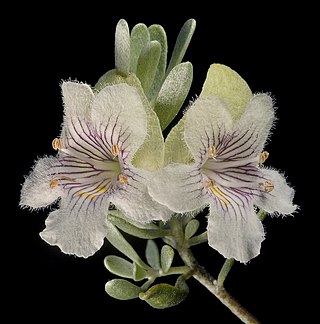
Prostanthera, commonly known as mintbush or mint bush, is a genus of about 100 species of flowering plants in the mint family Lamiaceae, and all are endemic to Australia. Plants are usually shrubs, rarely trees with leaves in opposite pairs. The flowers are arranged in panicles in the leaf axils or on the ends of branchlets. The sepals are joined at the base with two lobes. The petals are usually blue to purple or white, joined in a tube with two "lips", the lower lip with three lobes and the upper lip with two lobes or notched.

Persoonia, commonly known as geebungs or snottygobbles, is a genus of about one hundred species of flowering plants in the family Proteaceae. Plants in the genus Persoonia are shrubs or small trees usually with smooth bark, simple leaves and usually yellow flowers arranged along a raceme, each flower with a leaf or scale leaf at the base. The fruit is a drupe.

Aristida is a very nearly cosmopolitan genus of plants in the grass family. Aristida is distinguished by having three awns (bristles) on each lemma of each floret. The genus includes about 300 species found worldwide, often in arid warm regions. This genus is among those colloquially called three-awnswiregrasses, speargrasses and needlegrasses. The name Aristida is derived from the Latin "arista", meaning "awn".

Ehrharta is a genus of plants in the grass family.
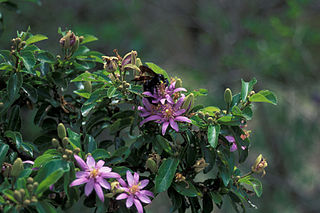
Grewia is a large flowering plant genus in the mallow family Malvaceae, in the expanded sense as proposed by the Angiosperm Phylogeny Group. Formerly, Grewia was placed in either the family Tiliaceae or the Sparrmanniaceae. However, these were both not monophyletic with respect to other Malvales - as already indicated by the uncertainties surrounding placement of Grewia and similar genera - and have thus been merged into the Malvaceae. Together with the bulk of the former Sparrmanniaceae, Grewia is in the subfamily Grewioideae and therein the tribe Grewieae, of which it is the type genus.
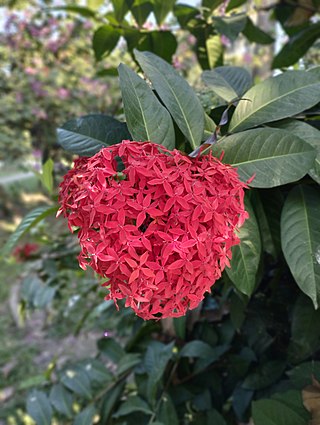
Ixora is a genus of flowering plants in the family Rubiaceae. It is the only genus in the tribe Ixoreae. It consists of tropical evergreen trees and shrubs and holds around 544 species. Though native to the tropical and subtropical areas throughout the world, its centre of diversity is in Tropical Asia. Ixora also grows commonly in subtropical climates in the United States, such as Florida where it is commonly known as West Indian jasmine.

Orites is a genus of nine plant species in the family Proteaceae − seven are endemic to Australia, one is endemic to the Chilean Andes and one to Bolivia.
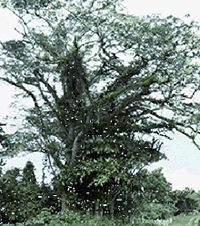
Serianthes is a genus of flowering plants in the family Fabaceae. It includes 17 species of trees and shrubs which range from Thailand and Malesia to Papuasia and the South Pacific. New Caledonia has the greatest diversity of species, with six endemic species. Typical habitats include tropical rain forest, scrub forest, coastal scrub, and rarely open wooded grassland.
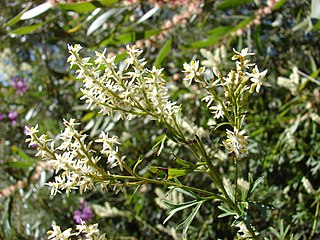
Symphionema is a genus of two species of small shrubs in the family Proteaceae. Both species are endemic to New South Wales in Australia.

Acidonia microcarpa is a species of shrub in the plant family Proteaceae. It is the only species in the genus Acidonia. It is endemic to the south coast of the Southwest Botanic Province of Western Australia.

Ehrharta calycina is a species of grass known by the common names perennial veldtgrass and purple veldtgrass.

Drosera microphylla, the golden rainbow, is an erect perennial tuberous species in the carnivorous plant genus Drosera. It is endemic to Western Australia and grows on granite outcrops or in sandy or laterite soils. D. microphylla produces small, circular, peltate carnivorous leaves along erect stems that can be 10–40 cm (4–16 in) high. It blooms from June to September, displaying its large golden sepals and smaller, variably-coloured petals. In populations near Perth, the petals are red, whereas petal colour near Albany tends to be orange. Some plants east of Esperance have white petals.
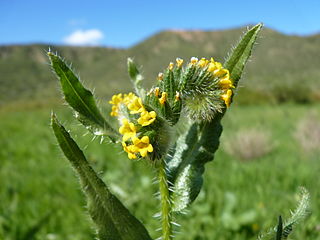
Amsinckia calycina, also known as hairy fiddleneck or yellow burweed, is a species of fiddleneck. It is native to Argentina and Chile and naturalised in Australia. It is an annual herb, growing to between 15 and 50 cm high and has pale yellow flowers. The species is poisonous to mammals.
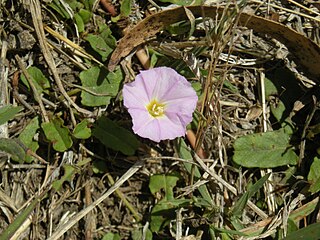
Polymeria is a genus of plants in the tribe Convolvuleae in the family Convolvulaceae. Plants of this genus typically bear at least somewhat elongated leaves with bases of an at least subtly sagittate shape. Other generic typicalities include a pink-mauve corolla with a white-and-yellow center, and a stigma divided into multiple – sometimes more than ten – parts.
Calycina is a genus of beetles in the family Mordellidae, containing the following species:

Aristida calycina, commonly known as dark wiregrass, is a species of grass in the family Poaceae that is native in Australia.

Themeda grassland, or Themeda grassland on seacliffs and headlands, is an endangered tussock-grassland that is found on the immediate coast in southeastern Australia, which may also be an open shrubland or heathland with a grassy enclosure between shrubs.


















